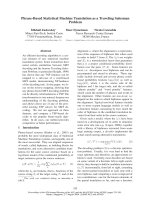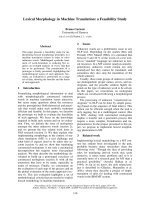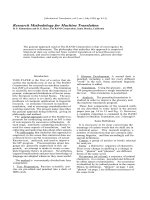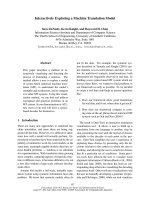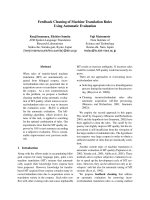Báo cáo khoa học: "Feedback Cleaning of Machine Translation Rules Using Automatic Evaluation" pot
Bạn đang xem bản rút gọn của tài liệu. Xem và tải ngay bản đầy đủ của tài liệu tại đây (61.51 KB, 8 trang )
Feedback Cleaning of Machine Translation Rules
Using Automatic Evaluation
Kenji Imamura, Eiichiro Sumita
ATR Spoken Language Translation
Research Laboratories
Seika-cho, Soraku-gun, Kyoto, Japan
{kenji.imamura,eiichiro.sumita}@atr.co.jp
Yuji Matsumoto
Nara Institute of
Science and Technology
Ikoma-shi, Nara, Japan
Abstract
When rules of transfer-based machine
translation (MT) are automatically ac-
quired from bilingual corpora, incor-
rect/redundant rules are generated due to
acquisition errors or translation variety in
the corpora. As a new countermeasure
to this problem, we propose a feedback
cleaning method using automatic evalua-
tion of MT quality, which removes incor-
rect/redundant rules as a way to increase
the evaluation score. BLEU is utilized
for the automatic evaluation. The hill-
climbing algorithm, which involves fea-
tures of this task, is applied to searching
for the optimal combination of rules. Our
experiments show that the MT quality im-
proves by 10% in test sentences according
to a subjective evaluation. This is consid-
erable improvement over previous meth-
ods.
1 Introduction
Along with the efforts made in accumulating bilin-
gual corpora for many language pairs, quite a few
machine translation (MT) systems that automati-
cally acquire their knowledge from corpora have
been proposed. However, knowledge for transfer-
based MT acquired from corpora contains many in-
correct/redundant rules due to acquisition errors or
translation variety in the corpora. Such rules con-
flict with other existing rules and cause implausible
MT results or increase ambiguity. If incorrect rules
could be avoided, MT quality would necessarily im-
prove.
There are two approaches to overcoming incor-
rect/redundant rules:
• Selecting appropriate rules in a disambiguation
process during the translation (on-line process-
ing, (Meyers et al., 2000)).
• Cleaning incorrect/redundant rules after
automatic acquisition (off-line processing,
(Menezes and Richardson, 2001; Imamura,
2002)).
We employ the second approach in this paper.
The cutoff by frequency (Menezes and Richardson,
2001) and the hypothesis test (Imamura, 2002) have
been applied to clean the rules. The cutoff by fre-
quency can slightly improve MT quality, but the im-
provement is still insufficient from the viewpoint of
the large number of redundant rules. The hypothesis
test requires very large corpora in order to obtain a
sufficient number of rules that are statistically confi-
dent.
Another current topic of machine translation is
automatic evaluation of MT quality (Papineni et al.,
2002; Yasuda et al., 2001; Akiba et al., 2001). These
methods aim to replace subjective evaluation in or-
der to speed up the development cycle of MT sys-
tems. However, they can be utilized not only as de-
velopers’ aids but also for automatic tuning of MT
systems (Su et al., 1992).
We propose feedback cleaning that utilizes
an automatic evaluation for removing incor-
rect/redundant translation rules as a tuning method
Training
Corpus
Automatic
Acquisition
Translation
Rules
Evaluation
Corpus
MT
Engine
Automatic
Evaluation
MT Results
Rule
Selection/Deletion
Feedback Cleaning
Figure 1: Structure of Feedback Cleaning
(Figure 1). Our method evaluates the contribution
of each rule to the MT results and removes inap-
propriate rules as a way to increase the evaluation
scores. Since the automatic evaluation correlates
with a subjective evaluation, MT quality will im-
prove after cleaning.
Our method only evaluates MT results and does
not consider various conditions of the MT engine,
such as parameters, interference in dictionaries, dis-
ambiguation methods, and so on. Even if an MT
engine avoids incorrect/redundant rules by on-line
processing, errors inevitably remain. Our method
cleans the rules in advance by only focusing on the
remaining errors. Thus, our method complements
on-line processing and adapts translation rules to the
given conditions of the MT engine.
2 MT System and Problems of Automatic
Acquisition
2.1 MT Engine
We use the Hierarchical Phrase Alignment-based
Translator (HPAT) (Imamura, 2002) as a transfer-
based MT system. The most important knowledge in
HPAT is transfer rules, which define the correspon-
dences between source and target language expres-
sions. An example of English-to-Japanese transfer
rules is shown in Figure 2. The transfer rules are
regarded as a synchronized context-free grammar.
When the system translates an input sentence, the
sentence is first parsed by using source patterns of
the transfer rules. Next, a tree structure of the tar-
get language is generated by mapping the source
patterns to the corresponding target patterns. When
non-terminal symbols remain in the target tree, tar-
get words are inserted by referring to a translation
dictionary.
Ambiguities, which occur during parsing or map-
ping, are resolved by selecting the rules that mini-
mize the semantic distance between the input words
and source examples (real examples in the training
corpus) of the transfer rules (Furuse and Iida, 1994).
For instance, when the input phrase “leave at 11
a.m.” is translated into Japanese, Rule 2 in Figure
2 is selected because the semantic distance from the
source example (arrive, p.m.) is the shortest to the
head words of the input phrase (leave, a.m.).
2.2 Problems of Automatic Acquisition
HPAT automatically acquires its transfer rules from
parallel corpora by using Hierarchical Phrase Align-
ment (Imamura, 2001). However, the rule set con-
tains many incorrect/redundant rules. The reasons
for this problem are roughly classified as follows.
• Errors in automatic rule acquisition
• Translation variety in corpora
– The acquisition process cannot generalize
the rules because bilingual sentences de-
pend on the context or the situation.
– Corpora contain multiple (paraphrasable)
translations of the same source expres-
sion.
In the experiment of Imamura (2002), about
92,000 transfer rules were acquired from about
120,000 bilingual sentences
1
. Most of these rules
are low-frequency. They reported that MT quality
slightly improved, even though the low-frequency
rules were removed to a level of about 1/9 the pre-
vious number. However, since some of them, such
as idiomatic rules, are necessary for translation, MT
quality cannot be dramatically improved by only re-
moving low-frequency rules.
3 Automatic Evaluation of MT Quality
We utilize BLEU (Papineni et al., 2002) for the au-
tomatic evaluation of MT quality in this paper.
BLEU measures the similarity between MT re-
sults and translation results made by humans (called
1
In this paper, the number of rules denotes the number of
unique pairs of source patterns and target patterns.
Rule No. Syn. Cat. Source Pattern Target Pattern Source Example
1 VP X
VP
at Y
NP
⇒ Y’ de X’ ((present, conference) )
2 VP X
VP
at Y
NP
⇒ Y’ ni X’ ((stay, hotel), (arrive, p.m) )
3 VP X
VP
at Y
NP
⇒ Y’ wo X’ ((look, it) )
4 NP X
NP
at Y
NP
⇒ Y’ no X’ ((man, front desk) )
Figure 2: Example of HPAT Transfer Rules
references). This similarity is measured by N-gram
precision scores. Several kinds of N-grams can be
used in BLEU. We use from 1-gram to 4-gram in
this paper, where a 1-gram precision score indicates
the adequacy of word translation and longer N-gram
(e.g., 4-gram) precision scores indicate fluency of
sentence translation. The BLEU score is calculated
from the product of N-gram precision scores, so this
measure combines adequacy and fluency.
Note that a sizeable set of MT results is necessary
in order to calculate an accurate BLEU score. Al-
though it is possible to calculate the BLEU score of a
single MT result, it contains errors from the subjec-
tive evaluation. BLEU cancels out individual errors
by summing the similarities of MT results. There-
fore, we need all of the MT results from the evalua-
tion corpus in order to calculate an accurate BLEU
score.
One feature of BLEU is its use of multiple ref-
erences for a single source sentence. However, one
reference per sentence is used in this paper because
an already existing bilingual corpus is applied to the
cleaning.
4 Feedback Cleaning
In this section, we introduce the proposed method,
called feedback cleaning. This method is carried out
by selecting or removing translation rules to increase
the BLEU score of the evaluation corpus (Figure 1).
Thus, this task is regarded as a combinatorial op-
timization problem of translation rules. The hill-
climbing algorithm, which involves the features of
this task, is applied to the optimization. The fol-
lowing sections describe the reasons for using this
method and its procedure. The hill-climbing al-
gorithm often falls into locally optimal solutions.
However, we believe that a locally optimal solution
is more effective in improving MT quality than the
previous methods.
4.1 Costs of Combinatorial Optimization
Most combinatorial optimization methods iterate
changes in the combination and the evaluation. In
the machine translation task, the evaluation process
requires the longest time. For example, in order to
calculate the BLEU score of a combination (solu-
tion), we have to translate C times, where C denotes
the size of the evaluation corpus. Furthermore, in
order to find the nearest neighbor solution, we have
to calculate all BLEU scores of the neighborhood.
If the number of rules is R and the neighborhood
is regarded as consisting of combinations made by
changing only one rule, we have to translate C × R
times to find the nearest neighbor solution. Assume
that C =10, 000 and R = 100, 000, the number
of sentence translations (sentences to be translated)
becomes one billion. It is infeasible to search for
the optimal solution without reducing the number of
sentence translations.
A feature of this task is that removing rules is eas-
ier than adding rules. The rules used for translating
a sentence can be identified during the translation.
Conversely, the source sentence set S[r], where a
rule r is used for the translation, is determined once
the evaluation corpus is translated. When r is re-
moved, only the MT results of S[r] will change,
so we do not need to re-translate other sentences.
Assuming that five rules on average are applied to
translate a sentence, the number of sentence trans-
lations becomes 5 × C + C =60, 000 for testing
all rules. On the contrary, to add a rule, the entire
corpus must be re-translated because it is unknown
which MT results will change by adding a rule.
4.2 Cleaning Procedure
Based on the above discussion, we utilize the hill-
climbing algorithm, in which the initial solution
contains all rules (called the base rule set) and the
search for a combination is done by only removing
static: C
eval
, an evaluation corpus
R
base
, a rule set acquired from the entire training corpus (the base rule set)
R, a current rule set, a subset of the base rule set
S[r], a source sentence set where the rule r is used for the translation
Doc
iter
, an MT result set of the evaluation corpus translated with the current rule set
procedure CLEAN-RULESET ()
R ← R
base
repeat
R
iter
← R
R
remove
←∅
score
iter
← SET-TRANSLATION()
for each r in R
iter
do
if S[r] = ∅ then
R ← R
iter
−{r}
translate all sentences in S[r], and obtain the MT results T [r]
Doc[r] ← the MT result set that T [r] is replaced from Doc
iter
the rule contribution contrib[r] ← score
iter
− BLEU-SCORE(Doc[r])
if contrib[r] < 0 then add r to R
remove
end
R ← R
iter
− R
remove
until R
remove
= ∅
function SET-TRANSLATION () returns a BLEU score of the evaluation corpus translated with R
Doc
iter
←∅
for each r in R
base
do S[r] ←∅end
for each s in C
eval
do
translate s and obtain the MT result t
obtain the rule set R[s] that is used for translating s
for each r in R[s] do add s to S[r] end
add t to Doc
iter
end
return BLEU-SCORE(Doc
iter
)
Figure 3: Feedback Cleaning Algorithm
rules. The algorithm is shown in Figure 3. This al-
gorithm can be summarized as follows.
• Translate the evaluation corpus first and then
obtain the rules used for the translation and the
BLEU score before removing rules.
• For each rule one-by-one, calculate the BLEU
score after removing the rule and obtain the dif-
ference between this score and the score before
the rule was removed. This difference is called
the rule contribution.
• If the rule contribution is negative (i.e., the
BLUE score increases after removing the rule),
remove the rule.
In order to achieve faster convergence, this algo-
rithm removes all rules whose rule contribution is
negative in one iteration. This assumes that the re-
moved rules are independent from one another.
5 N-fold Cross-cleaning
In general, most evaluation corpora are smaller than
training corpora. Therefore, omissions of cleaning
Training
Corpus
Training
Evaluation
Training
Evaluation
Training
Evaluation
Training
Base
Rule Set
Rule
Subset 1
Rule
Subset 2
Rule
Subset 3
Feedback
Cleaning
Feedback
Cleaning
Feedback
Cleaning
Rule
Deletion
Rule Contributions
Cleaned
Rule Set
Divide
Figure 4: Structure of Cross-cleaning
(In the case of three-fold cross-cleaning)
will remain because not all rules can be tested by the
evaluation corpus. In order to avoid this problem, we
propose an advanced method called cross-cleaning
(Figure 4), which is similar to cross-validation.
The procedure of cross-cleaning is as follows.
1. First, create the base rule set from the entire
training corpus.
2. Next, divide the training corpus into N pieces
uniformly.
3. Leave one piece for the evaluation, acquire
rules from the rest (N − 1) of the pieces, and
repeat them N times. Thus, we obtain N pairs
of rule set and evaluation sub-corpus. Each rule
set is a subset of the base rule set.
4. Apply the feedback cleaning algorithm to each
of the N pairs and record the rule contributions
even if the rules are removed. The purpose of
this step is to obtain the rule contributions.
5. For each rule in the base rule set, sum up the
rule contributions obtained from the rule sub-
sets. If the sum is negative, remove the rule
from the base rule set.
The major difference of this method from cross-
validation is Step 5. In the case of cross-cleaning,
Set Name Feature English Japanese
Training # of Sentences 149,882
Corpus
# of Words 868,087 984,197
Evaluation # of Sentences 10,145
Corpus
# of Words 59,533 67,554
Test # of Sentences 10,150
Corpus
# of Words 59,232 67,193
Table 1: Corpus Size
the rule subsets cannot be directly merged because
some rules have already been removed in Step 4.
Therefore, we only obtain the rule contributions
from the rule subsets and sum them up. The summed
contribution is an approximate value of the rule
contribution to the entire training corpus. Cross-
cleaning removes the rules from the base rule set
based on this approximate contribution.
Cross-cleaning uses all sentences in the training
corpus, so it is nearly equivalent to applying a large
evaluation corpus to feedback cleaning, even though
it does not require specific evaluation corpora.
6 Evaluation
In this section, the effects of feedback cleaning are
evaluated by using English-to-Japanese translation.
6.1 Experimental Settings
Bilingual Corpora The corpus used in the fol-
lowing experiments is the Basic Travel Expression
Corpus (Takezawa et al., 2002). This is a collec-
tion of Japanese sentences and their English trans-
lations based on expressions that are usually found
in phrasebooks for foreign tourists. We divided it
into sub-corpora for training, evaluation, and test as
shown in Table 1. The number of rules acquired
from the training corpus (the base rule set size) was
105,588.
Evaluation Methods of MT Quality We used the
following two methods to evaluate MT quality.
1. Test Corpus BLEU Score
The BLUE score was calculated with the test
corpus. The number of references was one for
each sentence, in the same way used for the
feedback cleaning.
0.22
0.24
0.26
0.28
0.3
0.32
0 1 2 3 4 5 6 7 8 9
80k
90k
100k
110k
120k
BLEU Score
Number of Rules
Number of Iterations
Test Corpus BLEU Score
Evaluation Corpus BLEU Score
Number of Rules
Figure 5: Relationship between Number of Itera-
tions and BLEU Scores/Number of Rules
2. Subjective Quality
A total of 510 sentences from the test corpus
were evaluated by paired comparison. Specif-
ically, the source sentences were translated us-
ing the base rule set, and the same sources were
translated using the rules after the cleaning.
One-by-one, a Japanese native speaker judged
which MT result was better or that they were
of the same quality. Subjective quality is repre-
sented by the following equation, where I de-
notes the number of improved sentences and D
denotes the number of degraded sentences.
Subj. Quality =
I − D
# of test sentences
(1)
6.2 Feedback Cleaning Using Evaluation
Corpus
In order to observe the characteristics of feedback
cleaning, cleaning of the base rule set was carried
out by using the evaluation corpus. The results are
shown in Figure 5. This graph shows changes in
the test corpus BLEU score, the evaluation corpus
BLEU score, and the number of rules along with the
number of iterations.
Consequently, the removed rules converged at
nine iterations, and 6,220 rules were removed. The
evaluation corpus BLEU score was improved by in-
creasing the number of iterations, demonstrating that
the combinatorial optimization by the hill-climbing
algorithm worked effectively. The test corpus BLEU
score reached a peak score of 0.245 at the second
iteration and slightly decreased after the third itera-
tion due to overfitting. However, the final score was
0.244, which is almost the same as the peak score.
The test corpus BLEU score was lower than
the evaluation corpus BLEU score because the
rules used in the test corpus were not exhaustively
checked by the evaluation corpus. If the evaluation
corpus size could be expanded, the test corpus score
would improve.
About 37,000 sentences were translated on aver-
age in each iteration. This means that the time for
an iteration is estimated at about ten hours if trans-
lation speed is one second per sentence. This is a
short enough time for us because our method does
not require real-time processing.
2
6.3 MT Quality vs. Cleaning Methods
Next, in order to compare the proposed methods
with the previous methods, the MT quality achieved
by each of the following five methods was measured.
1. Baseline
The MT results using the base rule set.
2. Cutoff by Frequency
Low-frequency rules that appeared in the train-
ing corpus less often than twice were removed
from the base rule set. This threshold was
experimentally determined by the test corpus
BLEU score.
3. χ
2
Test
The χ
2
test was performed in the same manner
as in Imamura (2002)’s experiment. We intro-
duced rules with more than 95 percent confi-
dence (χ
2
≥ 3.841).
4. Simple Feedback Cleaning
Feedback cleaning was carried out using the
evaluation corpus in Table 1.
5. Cross-cleaning
N-fold cross-cleaning was carried out. We ap-
plied five-fold cross-cleaning in this experi-
ment.
The results are shown in Table 2. This table shows
that the test corpus BLEU score and the subjective
2
In this experiment, it took about 80 hours until convergence
using a Pentium 4 2-GHz computer.
Previous Methods Proposed Methods
Baseline Cutoff by Freq. χ
2
Test Simple FC Cross-cleaning
# of Rules 105,588 26,053 1,499 99,368 82,462
Test Corpus BLEU Score 0.232 0.234 0.157 0.244 0.277
Subjective Quality +1.77% -6.67% +6.67% +10.0%
# of Improved Sentences
83 115 83 100
# of Same Quality
353 246 378 361
(Same Results)
(257) (114) (266) (234)
# of Degraded Sentences
74 149 49 49
Table 2: MT Quality vs. Cleaning Methods
quality of the proposed methods (simple feedback
cleaning and cross-cleaning) are considerably im-
proved over those of the previous methods.
Focusing on the subjective quality of the proposed
methods, some MT results were degraded from the
baseline due to the removal of rules. However, the
subjective quality levels were relatively improved
because our methods aim to increase the portion of
correct MT results.
Focusing on the number of the rules, the rule
set of the simple feedback cleaning is clearly a lo-
cally optimal solution, since the number of rules
is more than that of cross-cleaning, although the
BLEU score is lower. In comparing the number of
rules in cross-cleaning with that in the cutoff by fre-
quency, the former is three times higher than the lat-
ter. We assume that the solution of cross-cleaning
is also the locally optimal solution. If we could find
the globally optimal solution, the MT quality would
certainly improve further.
7 Discussion
7.1 Other Automatic Evaluation Methods
The idea of feedback cleaning is independent of
BLEU. Some automatic evaluation methods of MT
quality other than BLEU have been proposed. For
example, Su et al. (1992), Yasuda et al. (2001), and
Akiba et al. (2001) measure similarity between MT
results and the references by DP matching (edit dis-
tances) and then output the evaluation scores. These
automatic evaluation methods that output scores are
applicable to feedback cleaning.
The characteristics common to these methods, in-
cluding BLEU, is that the similarity to references
are measured for each sentence, and the evaluation
score of an MT system is calculated by aggregating
the similarities. Therefore, MT results of the eval-
uation corpus are necessary to evaluate the system,
and reducing the number of sentence translations is
an important technique for all of these methods.
The effects of feedback cleaning depend on the
characteristics of objective measures. DP-based
measures and BLEU have different characteristics
(Yasuda et al., 2003). The exploration of several
measures for feedback cleaning remains an interest-
ing future work.
7.2 Domain Adaptation
When applying corpus-based machine translation to
a different domain, bilingual corpora of the new do-
main are necessary. However, the sizes of the new
corpora are generally smaller than that of the orig-
inal corpus because the collection of bilingual sen-
tences requires a high cost.
The feedback cleaning proposed in this paper can
be interpreted as adapting the translation rules so
that the MT results become similar to the evaluation
corpus. Therefore, if we regard the bilingual corpus
of the new domain as the evaluation corpus and carry
out feedback cleaning, the rule set will be adapted to
the new domain. In other words, our method can be
applied to adaptation of an MT system by using a
smaller corpus of the new domain.
8 Conclusions
In this paper, we proposed a feedback cleaning
method that utilizes automatic evaluation to remove
incorrect/redundant translation rules. BLEU was
utilized for the automatic evaluation of MT qual-
ity, and the hill-climbing algorithm was applied to
searching for the combinatorial optimization. Uti-
lizing features of this task, incorrect/redundant rules
were removed from the initial solution, which con-
tains all rules acquired from the training corpus. In
addition, we proposed N-fold cross-cleaning to re-
duce the influence of the evaluation corpus size. Our
experiments show that the MT quality was improved
by 10% in paired comparison and by 0.045 in the
BLEU score. This is considerable improvement over
the previous methods.
Acknowledgment
The research reported here is supported in part by
a contract with the Telecommunications Advance-
ment Organization of Japan entitled, “A study of
speech dialogue translation technology based on a
large corpus.”
References
Yasuhiro Akiba, Kenji Imamura, and Eiichiro Sumita.
2001. Using multiple edit distances to automatically
rank machine translation output. In Proceedings of
Machine Translation Summit VIII, pages 15–20.
Osamu Furuse and Hitoshi Iida. 1994. Constituent
boundary parsing for example-based machine transla-
tion. In Proceedings of COLING-94, pages 105–111.
Kenji Imamura. 2001. Hierarchical phrase alignment
harmonized with parsing. In Proceedings of the 6th
Natural Language Processing Pacific Rim Symposium
(NLPRS 2001), pages 377–384.
Kenji Imamura. 2002. Application of translation knowl-
edge acquired by hierarchical phrase alignment for
pattern-based MT. In Proceedings of the 9th Confer-
ence on Theoretical and Methodological Issues in Ma-
chine Translation (TMI-2002), pages 74–84.
Arul Menezes and Stephen D. Richardson. 2001. A
best first alignment algorithm for automatic extrac-
tion of transfer mappings from bilingual corpora. In
Proceedings of the ‘Workshop on Example-Based Ma-
chine Translation’ in MT Summit VIII, pages 35–42.
Adam Meyers, Michiko Kosaka, and Ralph Grishman.
2000. Chart-based translation rule application in ma-
chine translation. In Proceedings of COLING-2000,
pages 537–543.
Kishore Papineni, Salim Roukos, Todd Ward, and Wei-
Jing Zhu. 2002. BLEU: a method for automatic eval-
uation of machine translation. In Proceedings of the
40th Annual Meeting of the Association for Computa-
tional Linguistics (ACL), pages 311–318.
Keh-Yih Su, Ming-Wen Wu, and Jing-Shin Chang. 1992.
A new quantitative quality measure for machine trans-
lation systems. In Proceedings of COLING-92, pages
433–439.
Toshiyuki Takezawa, Eiichiro Sumita, Fumiaki Sugaya,
Hirofumi Yamamoto, and Seiichi Yamamoto. 2002.
Toward a broad-coverage bilingual corpus for speech
translation of travel conversations in the real world.
In Proceedings of the Third International Conference
on Language Resources and Evaluation (LREC 2002),
pages 147–152.
Keiji Yasuda, Fumiaki Sugaya, Toshiyuki Takezawa, Sei-
ichi Yamamoto, and Masuzo Yanagida. 2001. An au-
tomatic evaluation method of translation quality using
translation answer candidates queried from a parallel
corpus. In Proceedings of Machine Translation Sum-
mit VIII, pages 373–378.
Keiji Yasuda, Fumiaki Sugaya, Toshiyuki Takezawa, Sei-
ichi Yamamoto, and Masuzo Yanagida. 2003. Appli-
cations of automatic evaluation methods to measuring
a capability of speech translation system. In Proceed-
ings of the 10th Conference of the European Chap-
ter of the Association for Computational Linguistics
(EACL 2003), pages 371–378.

